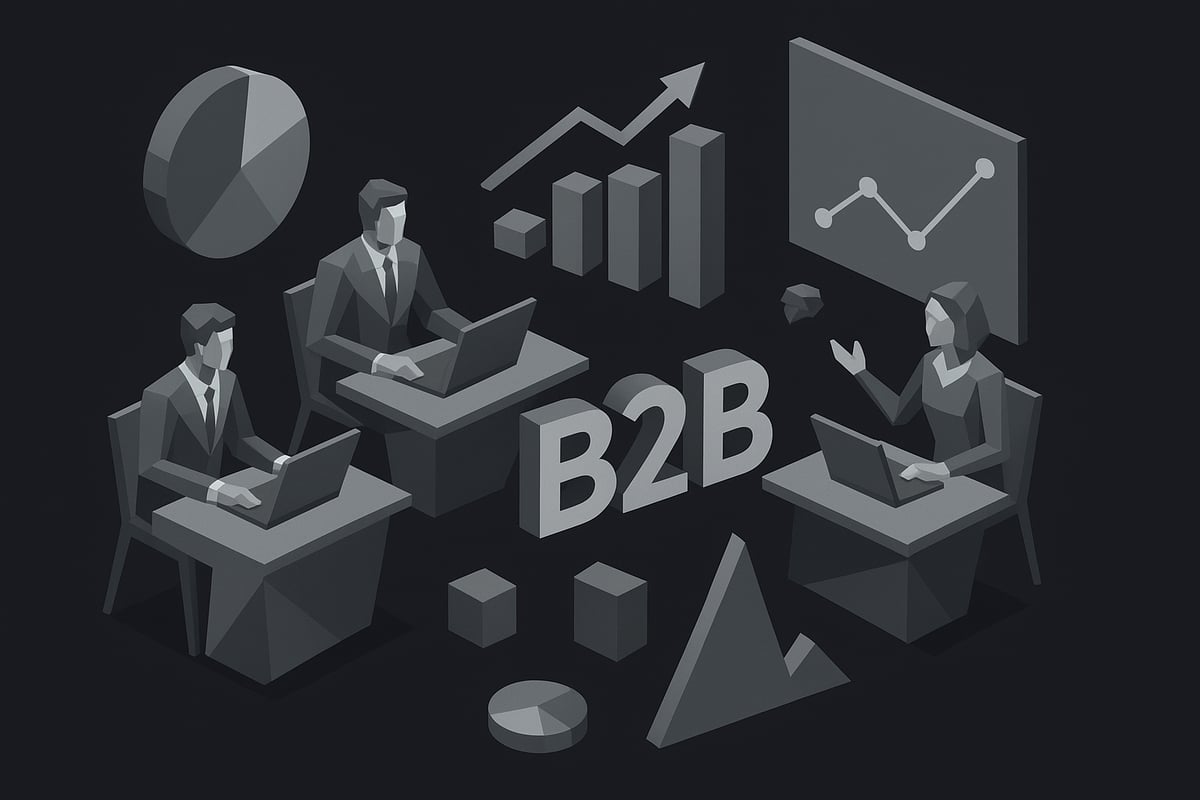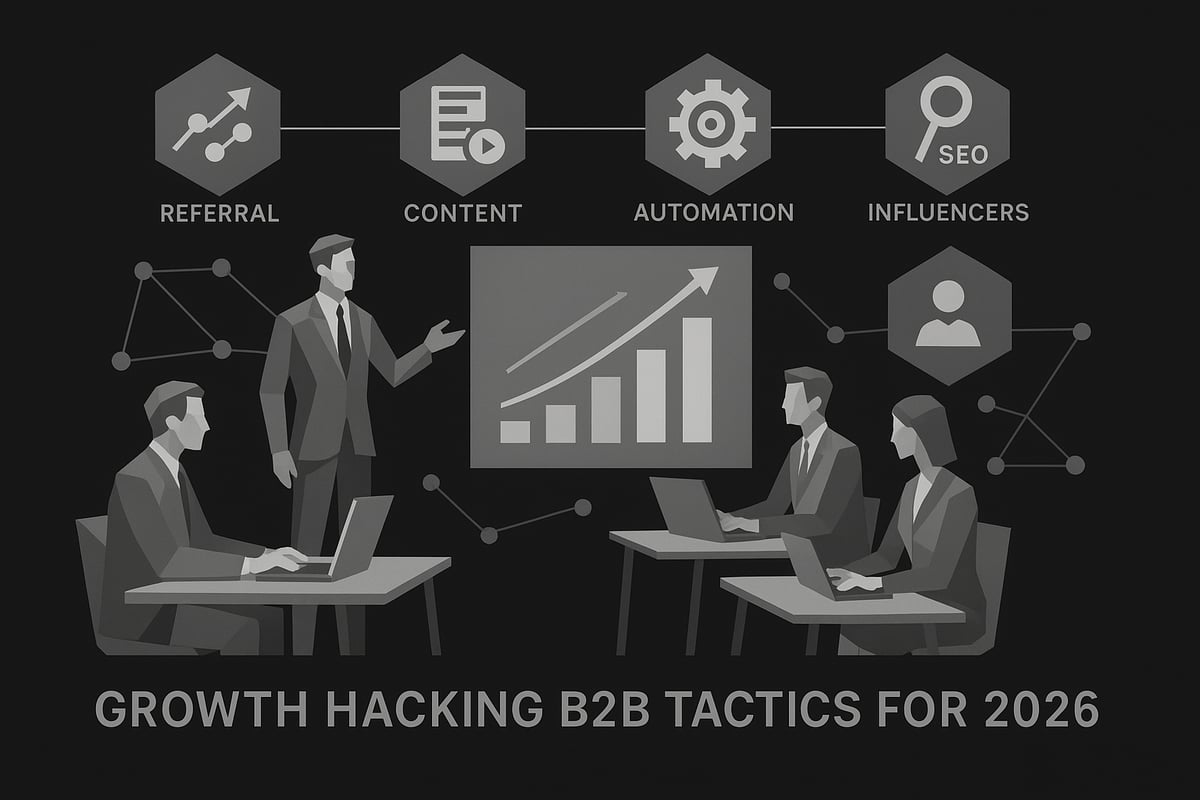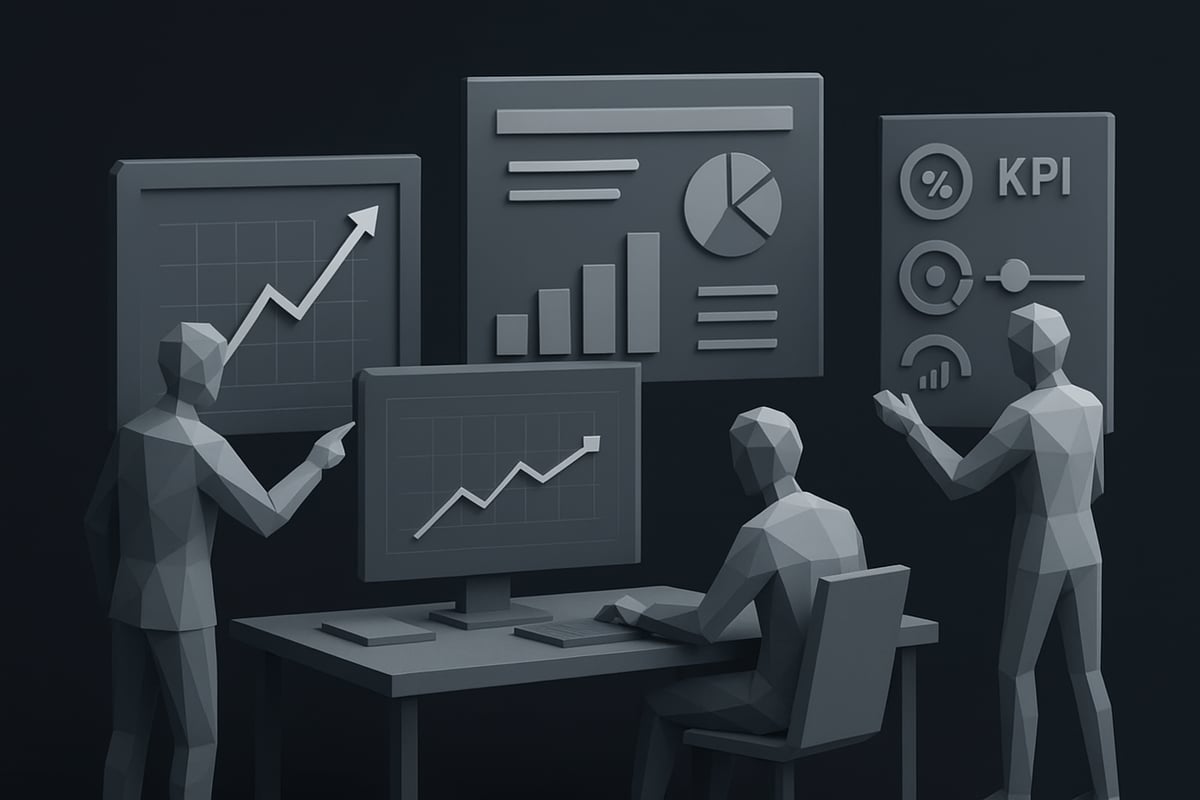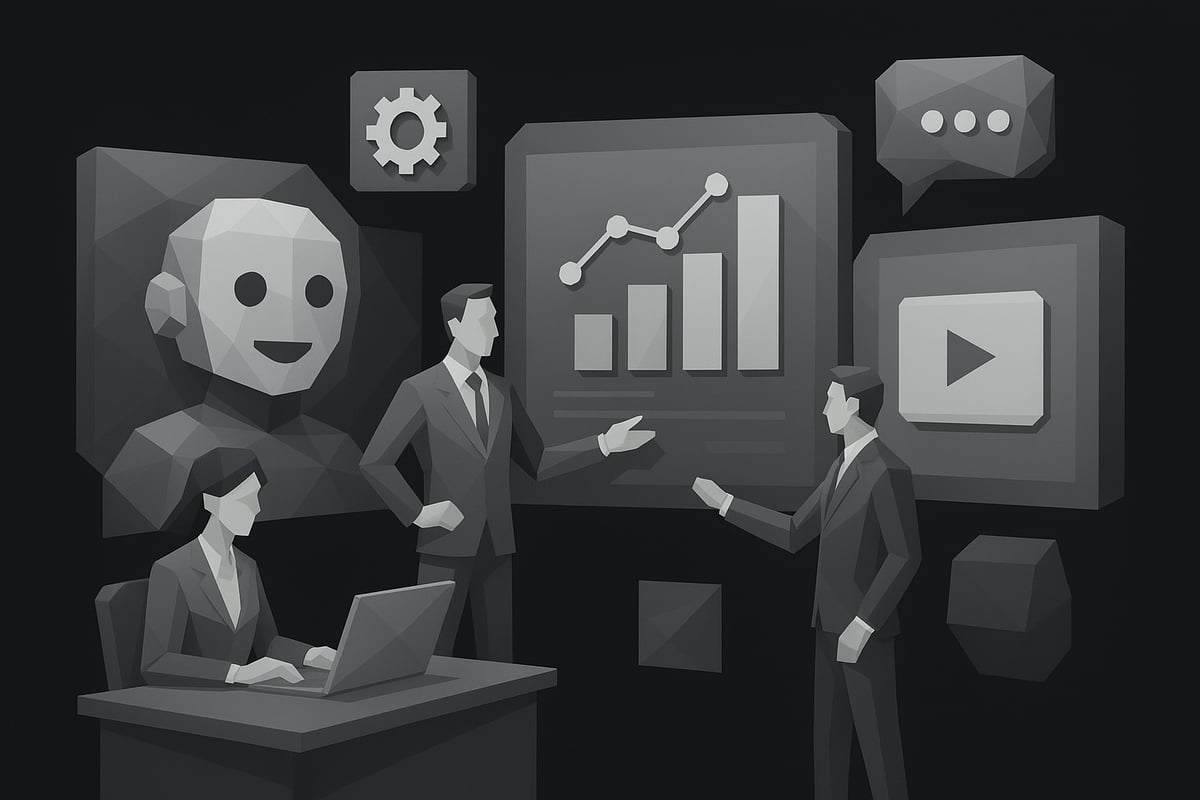The race to achieve rapid growth in the B2B world is fiercer than ever as 2026 approaches. Companies face mounting competition, shifting buyer expectations, and tighter budgets. How can you break through and accelerate your success? Growth hacking b2b offers a strategic, data-driven approach designed for companies determined to outpace their rivals. In this article, you will discover 7 actionable, proven growth hacking tactics tailored for B2B businesses in 2026. Ready to transform your results? Explore these strategies and take decisive steps to ignite your company’s next stage of growth.
Understanding Growth Hacking in B2B: Why It Matters in 2026
Growth hacking b2b has transformed how companies approach business expansion. Unlike traditional marketing, it is defined by rapid experimentation, data-driven choices, and creative tactics designed for measurable, scalable results. Growth hacking b2b is not just about driving awareness, but about continuously testing and optimizing every touchpoint to accelerate growth. This shift is especially important as B2B companies face mounting pressure to adapt quickly in a hyper-competitive landscape.
The key distinction between growth hacking b2b and B2C growth hacking lies in the complexity of relationships, longer sales cycles, and the critical need for trust. B2B decision-makers expect deeper personalization and strategic engagement. In 2026, growth hacking b2b becomes essential as buyer behaviors evolve, competition intensifies, and budgets tighten. Companies must innovate to capture attention and nurture leads effectively.
Technology and automation are now at the heart of growth hacking b2b strategies. Modern B2B firms, particularly SaaS businesses, use automation to personalize communication at scale, streamline referrals, and optimize campaigns in real time. For instance, many successful SaaS companies have implemented innovative acquisition tactics outlined in resources like B2B SaaS growth ideas, enabling them to outpace competitors and achieve rapid growth. Data supports this trend: 84% of B2B buyers expect personalized outreach, while nearly 70% of customers abandon online carts, challenges that growth hacking b2b methods are built to address.
Ultimately, growth hacking b2b is more than a toolkit; it is a mindset shift. It empowers teams to embrace experimentation, act on insights, and scale what works. By adopting growth hacking b2b principles, organizations of any size can build sustainable, repeatable systems for growth in 2026 and beyond.

7 Growth Hacking B2B Tactics to Boost Your Business in 2026
B2B leaders in 2026 know that growth hacking b2b tactics are not optional—they are essential for survival and competitive advantage. The landscape is more dynamic than ever, and companies that deploy creative, data-driven strategies will outpace those stuck in traditional approaches. In this section, discover seven proven growth hacking b2b tactics designed to help you scale efficiently, engage decision-makers, and future-proof your business. Each tactic draws on real-world examples and industry insights, providing a practical roadmap for your team.

1. Leverage Automated Referral Programs
Referral programs are a cornerstone of growth hacking b2b because they tap into trust networks and scale rapidly. By automating referral processes, you empower satisfied clients and partners to become brand advocates, driving new leads at a fraction of the cost of traditional acquisition.
Benefits:
- Builds credibility through peer recommendations
- Scales acquisition efficiently
- Reduces customer acquisition cost
Implementing automated referrals is straightforward. Integrate a digital referral system within your CRM or customer portal. Personalize invitations so they feel genuine, and incentivize referrals with rewards such as discounts, cash bonuses, or access to premium features.
A classic example is Dropbox, whose referral program drove 3,900 percent user growth. In B2B, SaaS companies often offer $100 account credits for every successful referral, fueling exponential expansion.
Data Table: Referral vs Paid Ads
| Acquisition Channel | Conversion Rate | Cost per Lead | Trust Factor |
|---|---|---|---|
| Automated Referrals | High | Low | High |
| Paid Ads | Medium | High | Medium |
Peer recommendations consistently outperform paid ads in B2B. According to recent studies, 84 percent of B2B buyers act on trusted referrals, and conversion rates are significantly higher when a peer is involved.
Tips for Success:
- Keep the sharing process frictionless
- Promote your program via email, social media, and your website
- Use analytics to monitor performance and optimize rewards
If you want to dive deeper into actionable strategies, check out these B2B growth hacking strategies for 2025, which include additional referral best practices.
2. Create Viral Content Marketing Campaigns
Viral content is a powerful growth hacking b2b lever because it amplifies your brand through organic sharing. Producing high-value, shareable content tailored to decision-makers—such as blogs, whitepapers, infographics, and case studies—positions your company as an industry authority.
Capitalize on trending topics, weave compelling stories, and feature expert interviews to make your content irresistible. Collaborate with industry influencers to extend your reach, and optimize every asset for SEO to maximize discoverability.
A great example is the use of “Top X” LinkedIn posts and visually engaging infographics. These assets spark industry conversations and drive traffic from targeted audiences.
Key Data:
- 87 percent of B2B marketers see positive ROI from video content
- Infographics can increase site traffic by up to 12 percent due to their visual appeal
Tips:
- Use storytelling to humanize complex topics
- Leverage LinkedIn for distribution
- Measure engagement and iterate on successful formats
Viral content not only accelerates your pipeline but also strengthens your company’s thought leadership position.
3. Implement Strategic Freemium Models and Free Trials
Offering a freemium model or a time-limited free trial is a proven growth hacking b2b tactic that lowers friction for new users and generates a steady pipeline of qualified leads. By showcasing your product’s core value upfront, you build trust and allow prospects to experience tangible benefits before committing.
How to Succeed:
- Design a basic tier that solves real problems
- Offer premium features as upgrade incentives
- Use in-app prompts and personalized messaging to guide users toward conversion
SaaS companies excel at this approach. Many have grown user bases rapidly by giving trial access, then upselling advanced features once users are engaged.
Freemium vs Free Trial Comparison
| Model | Pros | Cons |
|---|---|---|
| Freemium | Ongoing lead generation, sticky | May attract non-serious users |
| Free Trial | Urgency, higher conversion | Short window, needs nurturing |
Research shows that free trials can increase conversion rates, especially when decision-makers can test solutions in their own workflow. A/B test trial lengths, feature sets, and upgrade triggers to find the optimal mix for your audience.
4. Supercharge Social Media Engagement (Especially LinkedIn)
Social media, especially LinkedIn, is a critical channel for growth hacking b2b. Building a strong presence where your buyers congregate allows for authentic engagement and authority-building.
Share tailored, high-value content and actively participate in industry groups. Use sponsored posts and advanced targeting to reach decision-makers. Engaging in comment threads and peer discussions helps you stay top-of-mind for potential buyers.
Take HR tech companies, for example. They leverage LinkedIn groups, influencer engagement, and targeted posts to generate qualified leads and nurture relationships.
Key Data:
- LinkedIn is the leading platform for B2B lead generation
- Personalized content increases engagement rates by up to 30 percent
Tips:
- Maintain consistency in posting and branding
- Focus on authentic, value-driven interactions
- Track engagement metrics to refine your approach
Regular participation in relevant conversations is essential for sustained visibility and trust.
5. Optimize Email Marketing & Automation for Personalization
Personalized email marketing remains a linchpin in growth hacking b2b, especially for nurturing long sales cycles. Segmentation by role, industry, or behavior enables hyper-targeted messaging that resonates with each recipient.
Leverage automation tools to trigger personalized sequences based on user actions—such as downloads, signups, or trial activity. Integrate dynamic content and custom offers to boost engagement and conversion rates.
For example, sales enablement platforms use in-trial personalized emails to drive upgrades, resulting in a 15 percent or higher increase in registrations.
Key Steps:
- Segment your database for precision targeting
- Set up automated campaigns for every stage of the funnel
- Continuously test subject lines, CTAs, and send times
Personalized automation enables scalable, consistent nurturing, which is vital for B2B growth hacking b2b success.
6. Harness Influencer Partnerships and Micro-Influencers
Influencer marketing is no longer just for B2C. Growth hacking b2b now depends on authentic endorsements from industry thought leaders and micro-influencers with highly engaged audiences.
Focus on building partnerships with influencers who have domain expertise and credibility. Collaborate on webinars, podcasts, group projects, or co-branded content to tap into new networks.
For instance, B2B brands have hosted webinars featuring multiple micro-influencers, reaching highly targeted audiences and driving actionable leads.
Why Micro-Influencers Matter:
- Higher engagement rates in niche communities
- Greater authenticity and trust
- Often outperform large influencers in B2B contexts
Tips:
- Track engagement, traffic, and conversions from influencer collaborations
- Invest in long-term relationships for sustained credibility
Influencer partnerships can be a catalyst for rapid, sustainable growth.
7. Deploy Advanced SEO Strategies for B2B Buyer Intent
SEO is foundational for growth hacking b2b, but success in 2026 requires a shift from simple keyword targeting to deep buyer intent analysis. Understand your audience’s pain points and structure your content to address their specific needs.
Optimize your website for technical SEO, including site speed, mobile responsiveness, and schema markup. Create content clusters around core topics and use FAQ sections to capture featured snippets.
Building authoritative backlinks through industry partnerships, guest posts, and directories ensures your content ranks for high-intent keywords.
Example Approach:
- Map out the buyer journey and align content to each stage
- Use tools to analyze competitor rankings and identify gaps
- Update and repurpose evergreen content to maintain relevance
SEO Impact Table
| SEO Element | Benefit |
|---|---|
| Technical SEO | Improved discoverability |
| Backlinks | Higher domain authority |
| Content Clusters | Better topic coverage |
| Schema Markup | Featured snippet opportunities |
SEO delivers compounding returns, driving organic traffic and high-quality leads over time. In the context of growth hacking b2b, it is the engine that powers sustainable success.
Measuring and Iterating Your B2B Growth Hacking Efforts
In the fast-paced world of growth hacking b2b, measurement and iteration are not optional, but essential. Without clear metrics and an agile approach, even the best tactics can fall short. To truly excel, companies must embed measurement and optimization at every stage of their strategy.

Setting KPIs and Success Metrics
Choosing the right metrics is the foundation of effective growth hacking b2b. Start by identifying the most relevant KPIs for your business model and goals. Common metrics include:
- Lead generation volume and quality
- Conversion rates at each funnel stage
- Customer acquisition cost (CAC)
- Retention and churn rates
- Return on investment (ROI)
Here’s a quick snapshot of core metrics for growth hacking b2b:
| Metric | Purpose | How to Track |
|---|---|---|
| Leads Generated | Assess acquisition effectiveness | CRM, analytics tools |
| Conversion Rate | Measure sales funnel efficiency | Web analytics, CRM |
| CAC | Evaluate cost efficiency | Finance & marketing reports |
| Retention Rate | Track customer loyalty | Subscription & usage data |
| ROI | Analyze profitability | Financial dashboards |
Next, leverage analytics and attribution tools to monitor performance across all channels. This data-driven approach allows you to see which growth hacking b2b tactics drive the most impact. Tools like Google Analytics, CRM dashboards, and marketing automation platforms provide granular insights.
Regular A/B testing is crucial. Test different subject lines, landing pages, or referral incentives. Analyze the results to refine your approach. For instance, a B2B SaaS company might use cohort analysis to compare retention rates between users acquired through referral programs versus standard campaigns.
Customer feedback is another goldmine for iteration. Use surveys, interviews, and behavioral data to uncover friction points and new opportunities. Integrate insights to optimize your messaging, offers, and onboarding experience.
Remember, companies that iterate rapidly on growth experiments consistently outperform those sticking to static plans. According to recent data, agile teams see higher lead generation and conversion rates, a key advantage in growth hacking b2b. For more in-depth guidance on optimizing your acquisition metrics, explore these lead generation strategies that complement your iterative process.
To put this into action:
- Define clear, measurable KPIs from the start
- Set up tracking and analytics integrations
- Schedule regular reviews and A/B tests
- Gather and act on customer feedback
- Adjust tactics and messaging based on real results
Continuous measurement and agile iteration are the cornerstones of growth hacking b2b success.
Establishing a feedback loop of testing, analyzing, and refining empowers your business to adapt faster than competitors. With the right mindset and systems, every experiment becomes an opportunity for scalable, repeatable growth.
Future-Proofing Your B2B Growth Strategy for 2026 and Beyond
Staying ahead of the curve is essential for any organization committed to growth hacking b2b strategies. The B2B landscape is evolving rapidly, and only companies that anticipate change will outpace their competitors in 2026.

Adapting to Emerging Trends and Technologies
To future-proof your growth hacking b2b efforts, you must embrace new technologies and trends as part of your core strategy. Artificial intelligence and automation are transforming how B2B organizations target, personalize, and manage marketing campaigns. By leveraging AI-driven tools, businesses can analyze data faster, deliver hyper-personalized experiences, and optimize every touchpoint for higher ROI. In fact, AI adoption driving ROI in B2B is becoming a defining factor for industry leaders.
Buyer expectations are shifting toward digital-first interactions. Video content, chatbots, and even voice search are becoming fundamental to the buyer journey. Growth hacking b2b is not just about adopting these platforms, but also about understanding how your audience engages and responds. Companies that adapt quickly to these shifts will maintain an edge.
To remain agile and innovative, consider these future-proofing strategies:
- Invest in continuous research on emerging channels and technologies.
- Pilot new platforms like video-first social networks or conversational AI.
- Encourage cross-functional collaboration between marketing, sales, and IT.
- Foster a culture that rewards experimentation and learning from failure.
A strong example is how leading firms are integrating AI for content creation, outreach, and analytics. This approach streamlines processes and uncovers new growth hacking b2b opportunities. According to recent data, 84% of B2B buyers now expect digital-first experiences, and AI adoption in marketing is projected to double by 2026.
The organizations that thrive will be those that treat growth hacking b2b as an ongoing journey, not a one-time project. Keep your strategies flexible and your teams empowered to test, learn, and adapt. By doing so, you will ensure your business is ready not just for 2026, but for whatever comes next.
After exploring these powerful growth hacking tactics, you now have a roadmap for scaling your B2B business in 2026 and beyond. You’ve seen how strategies like automation, personalization, and influencer partnerships can unlock new opportunities and accelerate your digital product journey. If you’re ready to take the next step and put these ideas into practice, I encourage you to start building your own success story today. The tools and guidance you need are just a click away—let’s turn your expertise into a thriving, self-sustaining business together.
Get Started